Introduction
Forearms, often overlooked in the realm of fitness, play a pivotal role in our daily activities and overall strength. These muscles, extending from the elbow to the wrist, are involved in almost every hand movement, from lifting weights at the gym to performing everyday tasks like typing or opening a jar.

The Significance of Forearm Muscles
The forearm comprises a complex network of muscles, each contributing to various hand and wrist functions. When you grip an object, twist a door handle, or even wave goodbye, you’re actively engaging these muscles. Their intricate design ensures both fine motor skills, like writing, and strength-based actions, like carrying heavy bags.
Why Forearm Strength Matters
Beyond the obvious physical implications, robust forearm strength enhances athletic performance across numerous sports. Be it tennis, where a strong grip determines racket control, or rock climbing, where forearm endurance is crucial, the benefits are manifold. Moreover, strong forearms provide stability to the upper arms, balancing the biceps and triceps, leading to a harmonious upper body strength. As a bonus, well-defined forearms are also aesthetically pleasing, giving a balanced look to the arms.
In the subsequent sections, we’ll dive deeper into the anatomy, exercises, and benefits of focusing on forearm strength, ensuring you’re equipped with comprehensive knowledge to build and maintain this crucial muscle group.
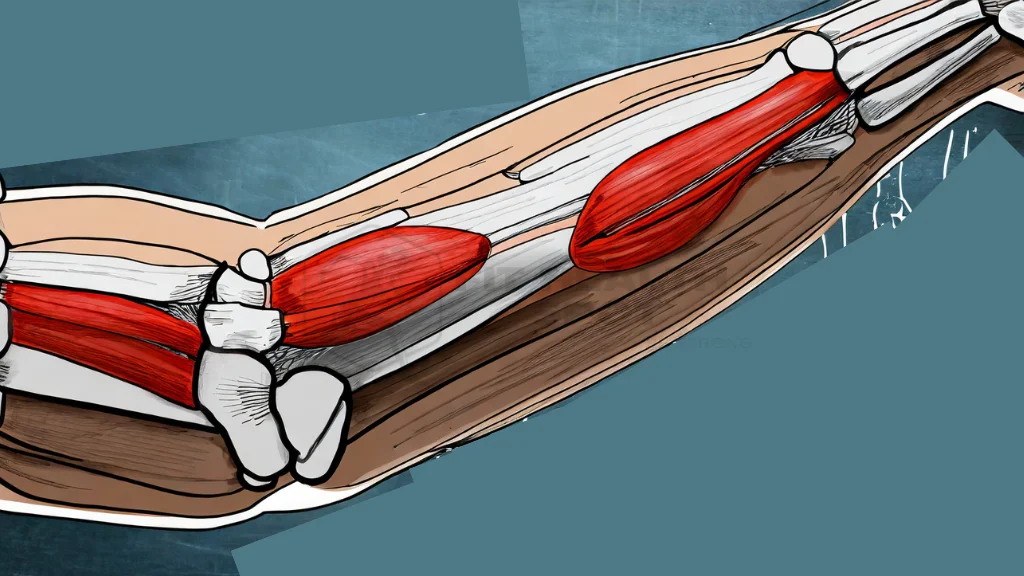
Forearms, while often overlooked in the fitness realm, play a pivotal role in our daily activities and overall strength. These muscles, extending from the elbow down to the wrist, are central to almost every hand movement, from gym routines involving lifting weights to mundane tasks like typing or opening a jar.
Diving deeper, the forearm is a web of intricate muscles, each contributing to various hand and wrist functions. The act of gripping an object, turning a door handle, or even the simple gesture of waving involves these muscles. Their design ensures a balance between fine motor skills, such as writing, and strength-driven actions like carrying heavy bags.
The benefits of robust forearm strength extend beyond physical aesthetics. It’s instrumental in athletic activities like tennis, where a formidable grip is crucial for racket control or rock climbing, demanding endurance from the forearms. Furthermore, strong forearms balance out the upper arms, complementing the biceps and triceps, resulting in a harmonized upper body strength.
Forearm Anatomy and Function
Understanding the Muscles of the Forearm
The forearm is home to over 20 muscles, categorized mainly into flexors and extensors. The flexor muscles, situated on the palm side, are tasked with bending the wrist and fingers. On the flip side, the extensor muscles, found on the forearm’s back, assist in extending the wrist and fingers. Each muscle connects through specific tendons to various points in the hand, facilitating precise movements.
Role of Forearms in Daily Life and Workouts
Our forearms are always at play, even in actions we seldom acknowledge. From lifting a coffee mug and typing away at a keyboard to holding onto a steering wheel, the forearms are in constant engagement. In the world of fitness, these muscles underscore exercises beyond just forearm-centric workouts. Activities like pull-ups, deadlifts, and even push-ups demand a sturdy grip, spotlighting the indispensability of fortified forearms. A deep understanding and focus on forearm strength can significantly uplift daily functionality and athletic capabilities.
Forearms, while often overlooked in the fitness realm, play a pivotal role in our daily activities and overall strength. These muscles, extending from the elbow down to the wrist, are central to almost every hand movement, whether it’s gym routines that involve lifting weights or mundane tasks like typing or opening a jar.
Diving deeper, the forearm is a web of intricate muscles, each contributing to various hand and wrist functions. The act of gripping an object, turning a door handle, or even the simple gesture of waving involves these muscles. Their design ensures a balance between fine motor skills, such as writing, and strength-driven actions. For those looking to focus on upper arm exercises, bicep curls are a fantastic complement to forearm workouts.
The benefits of robust forearm strength extend beyond physical aesthetics. It’s instrumental in athletic activities like tennis, where a formidable grip is crucial for racket control, or personalized exercises, which tailor workouts to individual needs, emphasizing the importance of forearm endurance. Furthermore, strong forearms balance out the upper arms, complementing the biceps and triceps, resulting in a harmonized upper body strength.
Forearm Workout Basics
Warm-Up Exercises for Forearms
Before diving into any workout, it’s essential to prepare your muscles. For forearms, this means ensuring that the muscles are warmed up, flexible, and ready to take on the strains of the exercises ahead. Warm-up routines can range from simple wrist rotations finger stretches, to squeezing soft stress balls. These initial steps help in increasing blood flow to the region, reducing the risk of injuries.

The Pillars of Form and Posture
Maintaining correct form and posture during forearm exercises is paramount. Proper form ensures that the right muscles are targeted, maximizing the workout’s benefits while minimizing the risk of strain or injury. Whether you’re using dumbbells, cables, or just body weight, always ensure your wrist movements are controlled and deliberate. Avoid unnecessary bending or twisting. Your posture, too, plays a significant role. Keeping a straight back and aligned shoulders not only aids in effective muscle engagement but also protects the spine and surrounding muscles from undue pressure.
As we delve deeper into specific workouts, we’ll further highlight the importance of form and posture, ensuring each exercise is performed to its utmost potential.
Forearm Workout Chart
Embarking on a fitness journey targeting the forearms requires a well-structured plan. This workout chart provides an overview of the exercises detailed in this blog, ensuring readers have a clear roadmap to follow. While individual needs may vary, this sequence is designed to yield maximum benefits for those committed to strengthening and toning their forearms.
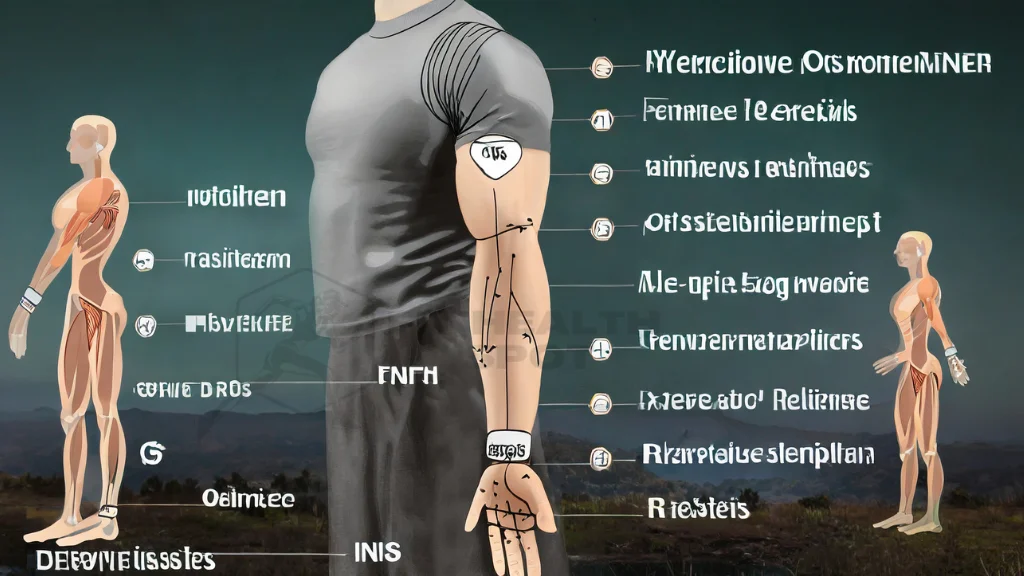
Overview of Exercises:
- Warm-Up Routine: As mentioned earlier, initiating wrist rotations, finger stretches, and stress ball squeezes prepares the muscles.
- Dumbbell Workouts: Incorporate moves like wrist curls and reverse wrist curls to target the flexor and extensor muscles.
- Cable Workouts: These provide resistance, allowing for controlled movements beneficial for muscle growth.
- Bodyweight Exercises: Activities like plank holds, which demand forearm strength to stabilize the body, can be surprisingly effective.
- Stretching & Cool Down: Post-workout, it’s essential to stretch the muscles, aiding recovery and flexibility.
For those looking to enhance their overall upper body strength, incorporating exercises like the lat spread can complement the forearm routines, offering a comprehensive workout experience.
Recommended Sequence for Maximum Benefits:
- Warm-Up: 10-15 minutes
- Dumbbell Workouts: 3 sets of 12-15 reps
- Cable Workouts: 3 sets of 12-15 reps
- Bodyweight Exercises: 3 sets for 30-60 seconds
- Cool Down & Stretching: 10-15 minutes
Following this sequence ensures a balanced workout, targeting the muscles effectively. It’s always a good idea to occasionally switch up the exercises to prevent plateaus and keep the routine engaging. Additionally, integrating workouts like wall pilates can aid in core strengthening, enhancing balance and stability, which is crucial for forearm exercises.
Dumbbell Workouts for Forearms
Dumbbell exercises are foundational in the realm of weight training, known for their versatility and effectiveness. Dumbbells provide a versatile set of exercises for forearm development, engaging both the flexor and extensor muscle groups, effectively enhancing strength, endurance, and muscle definition.
Exercise 1: Dumbbell Wrist Curls
- Description: This exercise primarily targets the forearm flexors. Holding a dumbbell in each hand, rest your arms on a bench with your wrists hanging off the edge.
- How to do it: With palms facing up, curl the dumbbells by flexing your wrists. Slowly lower them back to the starting position.
- Benefits: Enhances grip strength and increases the size of the forearm flexors.
- Common Mistakes: Using too much weight can lead to poor form. Ensure you have a controlled motion throughout the exercise.
- Expert Tip: For a more in-depth guide on this exercise, check out this complete guide to wrist curls.

Exercise 2: Dumbbell Reverse Wrist Curls
- Description: This exercise focuses on the forearm extensors. Similar to the wrist curls, but with palms facing down.
- How to do it: Hold a dumbbell in each hand and rest your arms on a bench with wrists hanging off the edge. With palms facing down, lift the dumbbells by extending your wrists. Lower them with control.
- Benefits: Strengthens the forearm extensors, balancing out the muscle development in the forearm.
- Common Mistakes: Avoid jerky movements. A smooth, controlled motion ensures maximum muscle engagement.
- Expert Tip: This exercise can be a great addition to a routine that includes nitric oxide dump exercises, promoting blood flow and muscle growth.
Exercise 3: Dumbbell Hammer Curls
- Description: A variation of the traditional bicep curl, this exercise engages both the biceps and the brachioradialis, a muscle of the forearm.
- How to do it: Grasp a dumbbell in both hands, extending your arms fully while keeping your palms directed towards your body. Maintain the position of your upper arms and curl the weights, engaging your biceps.
- Benefits: Builds overall arm strength and adds definition to the forearms and biceps.
- Common Mistakes: Swinging the dumbbells or using momentum. Ensure you’re lifting with your muscles, not momentum.
- Expert Tip: Incorporating exercises that focus on both the upper and lower body, like the comparison between hack squats, leg press, and traditional squats, can provide a well-rounded workout regimen.
These exercises, when performed consistently and with proper form, can significantly enhance forearm strength and aesthetics. As with any workout routine, it’s crucial to listen to your body and make adjustments as needed.
Cable Workouts for Forearms
Cable machines, often found in most gyms, provide consistent resistance throughout an exercise, making them an excellent tool for targeted muscle development. The adjustable weights and pulley systems allow for a variety of exercises, including those tailored for the forearms. These exercises can be adjusted to suit one’s strength levels, ensuring progressive muscle development.
Exercise 1: Cable Wrist Curls
- Description: This exercise, akin to the dumbbell wrist curl, targets the forearm flexors but offers constant tension due to the cable machine.
- How to do it: Connect a straight bar to the low pulley. While seated, grip the bar with palms facing up, resting your forearms on your thighs with wrists hanging over your knees. Curl the bar upwards by flexing your wrists, then slowly lower it back.
- Benefits: Offers enhanced muscle engagement due to the constant resistance of the cable.
- Common Mistakes: Moving the entire arm instead of isolating the wrist movement.
- Expert Tip: Incorporating a range of exercises, such as those found in a comprehensive calisthenics workout, can help diversify your fitness regimen.
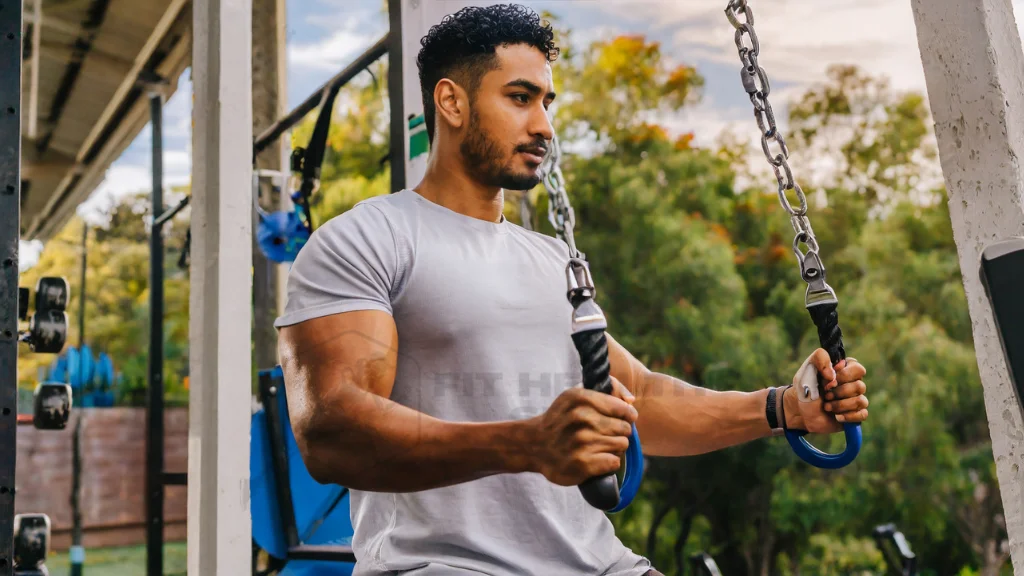
Exercise 2: Cable Reverse Wrist Curls
- Description: A counterpart to the wrist curl, this focuses on the forearm extensors.
- How to do it: Use the same setup as the wrist curl, but grip the bar with palms facing down. Lift the bar by extending your wrists, then lower with control.
- Benefits: Targets the extensor muscles, balancing forearm development.
- Common Mistakes: Using excessive weight leads to compromised form.
- Expert Tip: It’s crucial to understand the importance of personalized exercises tailored to individual needs for optimal benefits.
Exercise 3: Cable Grip Strengthener
- Description: Utilizing a rope attachment, this exercise targets the overall grip strength.
- How to do it: Attach a rope to the low pulley and stand facing the machine. Grip the rope ends and pull it towards you by squeezing your hands, then release slowly.
- Benefits: Enhances overall grip strength, useful for various athletic activities.
- Common Mistakes: Rapid movements without controlled release.
- Expert Tip: Strengthening the lower body with exercises like lunges can complement upper-body workouts for a full-body routine.
Cable exercises for the forearms offer the benefit of consistent resistance, ensuring every rep is as effective as possible. Remember to adjust the weights to a comfortable level, progressively increasing them as your strength improves.
Forearm Exercise Equipment
When targeting the forearms, various equipment options are available, each with its unique benefits and potential drawbacks. Let’s delve into some of the popular choices and understand their implications.
Dumbbells
- Benefits: They are versatile and can be used for a range of exercises. Dumbbells offer the ability to target each arm independently, ensuring balanced strength development.
- Drawbacks: The resistance is not constant throughout the movement, unlike cable machines.
- Expert Recommendations: Dumbbells are foundational and should be a part of everyone’s fitness toolkit. They’re especially suitable for beginners and those looking to work on muscle imbalances.
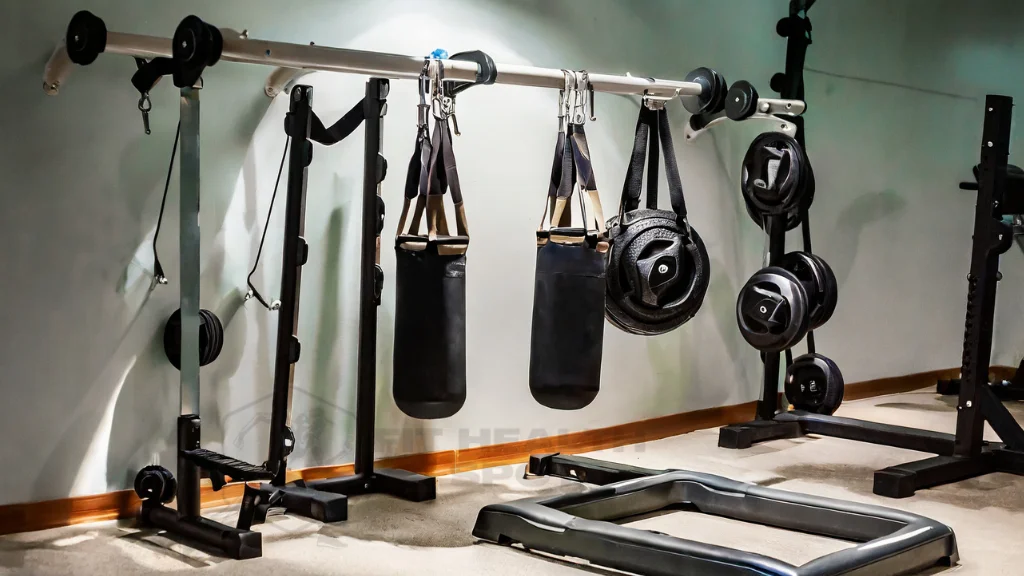
Cable Machines
- Benefits: They provide constant resistance, ensuring effective muscle engagement throughout the movement.
- Drawbacks: They are less portable than dumbbells and may require access to a well-equipped gym.
- Expert Recommendations: Ideal for intermediate and advanced trainees. The adjustable resistance caters to progressive overload, which is essential for muscle growth.
Wrist Rollers
- Benefits: They specifically target grip strength and endurance. Wrist rollers are simple yet effective, requiring the user to roll a weight up and down a shaft.
- Drawbacks: They focus primarily on endurance rather than muscle building.
- Expert Recommendations: Great for athletes or individuals who require enhanced grip endurance, like climbers.
Grip Strengtheners
- Benefits: Portable devices that can be used anywhere. They offer resistance when squeezed, enhancing grip strength.
- Drawbacks: Limited in terms of overall forearm development.
- Expert Recommendations: Suitable for those looking to improve hand strength, such as tennis players or musicians.
Barbell Exercises
- Benefits: Allows for heavy lifting and compound movements. Exercises like the sumo deadlift engage the forearms due to the grip required to hold the barbell.
- Drawbacks: Requires proper form and technique to avoid injuries.
- Expert Recommendations: Ideal for those familiar with weightlifting. Ensure to maintain proper form, especially during compound exercises.
Additionally, while not strictly forearm-specific, exercises that strengthen the back and core, like hyperextensions, can complement forearm workouts by providing overall stability and strength.
Machine Workouts for Forearms
Beyond dumbbells and cables, specialized machines in the gym are dedicated to enhancing forearm strength and muscle definition. These machines are designed to isolate specific muscle groups, providing targeted resistance that can be easily adjusted to fit individual strength levels.
Exercise 1: Forearm Curl Machine
- Description: This machine is specially designed to target the flexor muscles of the forearm.
- How to do it: Adjust the weight to a comfortable resistance. Sit and place your forearms on the padded rest, with your wrists positioned over the edge. Grip the handles and curl up, then slowly release.
- Benefits: Offers isolated targeting of the forearm flexors with adjustable resistance.
- Common Mistakes: Lifting too heavy too soon which can lead to strain.
- Expert Tip: It’s essential to complement forearm exercises with workouts targeting other parts of the body. For instance, exercises like Bulgarian squats can strengthen the lower body, ensuring a well-rounded fitness regimen.
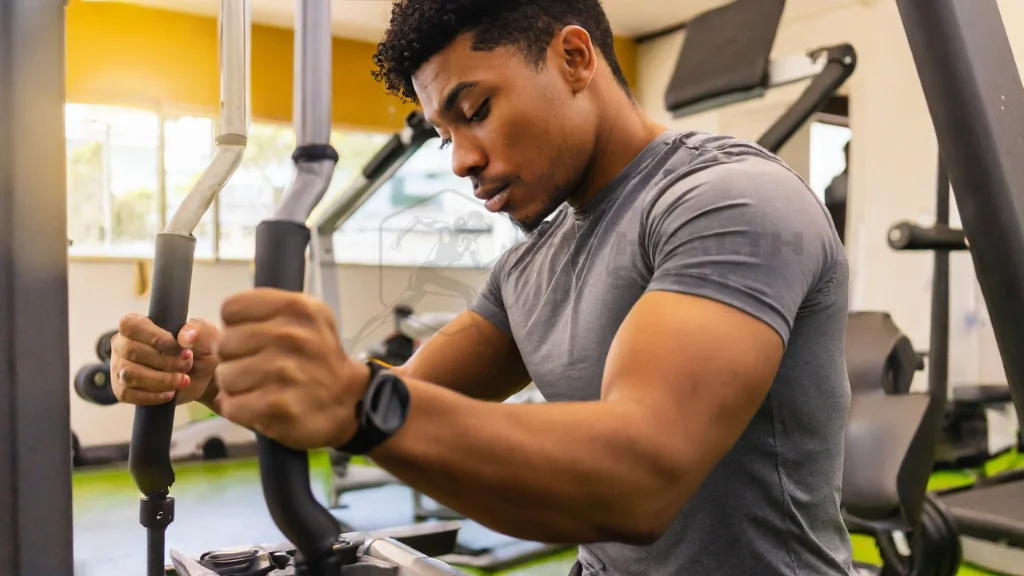
Exercise 2: Forearm Extension Machine
- Description: A counterpart to the forearm curl machine, this focuses on the extensor muscles.
- How to do it: After setting your desired weight, sit and place your forearms on the pad, wrists over the edge, but with palms facing down. Grip the handles and lift, then lower with control.
- Benefits: Isolates and targets the extensor muscles of the forearm.
- Common Mistakes: Overextending the wrists which can lead to injury.
- Expert Tip: Consistency is key. Ensure you’re progressively increasing the weight as your strength improves.
Exercise 3: Grip Strength Machine
- Description: This machine focuses on enhancing overall grip strength.
- How to do it: Adjust the resistance, grip the handles, and squeeze them together. Hold for a moment, then release slowly.
- Benefits: Strengthens the entire hand, enhancing grip strength, which is beneficial for various athletic activities.
- Common Mistakes: Using the machine too frequently without adequate rest can lead to overuse injuries.
- Expert Tip: Grip strength is crucial for exercises that involve pulling movements. Lat workouts, for example, require a strong grip to engage the back muscles effectively.
Exercises for the forearm using machines enable precise targeting, enabling users to concentrate on particular muscle groups. As always, ensure you warm up adequately and maintain proper form to maximize benefits and prevent injuries.
Forearm Rotation Exercises
Forearm rotation exercises play a crucial role in strengthening the pronators and supinators of the forearm. These muscles are responsible for turning the hand palm up (supination) and palm down (pronation). Training these movements enhances wrist stability, reduces the risk of injuries, and improves functionality in tasks that require rotational wrist movements.
Exercise 1: Dumbbell Pronation and Supination
- Description: This simple exercise targets both the pronators and supinators using a dumbbell.
- How to do it: Sit on a bench with a dumbbell in one hand, elbow bent at 90 degrees. Rotate your forearm to turn your palm up (supination), then rotate it to turn your palm down (pronation).
- Benefits: Strengthens the muscles responsible for wrist rotation and enhances wrist stability.
- Common Mistakes: Using a heavy dumbbell that compromises the range of motion.
- Expert Tip: Ensure the movement is controlled and avoid any jerky motions.

Exercise 2: Resistance Band Forearm Rotation
- Description: Using a resistance band to add tension to the rotational movement.
- How to do it: Anchor a resistance band at waist height. Hold the other end with your hand, elbow bent at 90 degrees. Rotate your forearm outward against the resistance, then inward.
- Benefits: The consistent tension of the resistance band provides a unique challenge, enhancing muscle endurance.
- Common Mistakes: Overstretching the band or using a band with too much resistance.
- Expert Tip: This exercise is excellent for rehabilitating wrist injuries, but always consult with a physical therapist before starting any rehab exercises.
Exercise 3: Barbell Forearm Rotation
- Description: This exercise utilizes a barbell to challenge the forearm rotational muscles.
- How to do it: Hold a barbell with both hands in front of you, palms facing down. Keeping your elbows locked by your sides, rotate the barbell forward and backward.
- Benefits: Engages both forearms simultaneously, ensuring balanced development.
- Common Mistakes: Using a barbell that’s too heavy leads to a reduced range of motion.
- Expert Tip: It’s essential to maintain a firm grip on the barbell throughout the exercise to maximize benefits.
Forearm rotation exercises are often overlooked, but they are essential for complete forearm development and functionality. Incorporating these movements into your routine can lead to improved performance in sports and daily activities alike.
Achieving ‘Popeye’ Forearms
The term “Popeye forearms” draws inspiration from the iconic cartoon character, Popeye the Sailor Man, known for his disproportionately large and muscular forearms. These forearms, which inflate to superhuman proportions after consuming spinach, have become symbolic of exceptional forearm strength and development. For many fitness enthusiasts, achieving such pronounced forearms represents a mix of dedication, targeted exercises, and, sometimes, a touch of genetic luck.
Significance of ‘Popeye Forearms’
- Symbol of Strength: Just as broad shoulders or a chiseled chest are hallmarks of physical prowess, well-developed forearms are often seen as a sign of genuine strength. This is because the forearms are constantly visible and play a critical role in grip strength, which is fundamental to various physical activities.
- Functional Benefits: Beyond aesthetics, having strong forearms translates to improved performance in daily tasks that require hand and wrist movements, from lifting bags to opening jars.

Tips and Tricks to Enhance Forearm Mass and Strength
- Consistent Training: Just like any other muscle group, forearms require consistent training to grow. Incorporate forearm-specific exercises into your routine at least twice a week.
- Varied Exercises: Ensure you’re targeting both the flexors and extensors of the forearm. Incorporate a mix of curls, extensions, and rotational exercises.
- Grip Challenges: Engage in exercises that challenge your grip strength. Deadlifts, pull-ups, and farmer’s walks with heavy dumbbells can be especially effective.\
- Mindful Eating: Ensure you’re consuming enough protein and calories to fuel muscle growth. A balanced diet, coupled with strength training, will support forearm development.
- Rest and Recovery: While it’s crucial to train hard, it’s equally vital to allow your muscles time to recover. Ensure you’re getting adequate rest between workouts, and consider incorporating forearm stretches to improve flexibility and reduce the risk of injury.
- Stay Patient: Forearms, given their dense muscle fiber composition, can take time to show visible growth. Stay consistent with your efforts, and the results will come.
While the exaggerated forearms of Popeye may remain a cartoon fantasy, with dedication, targeted training, and proper nutrition, one can indeed achieve impressive and functionally strong forearms in the real world.
Benefits of Forearm Workouts
Forearm exercises, while often overlooked, bring forth a multitude of advantages that extend beyond just physical appearance. Understanding these benefits can be a motivating factor to incorporate them into one’s fitness routine consistently:
- Boosted Grip Strength: Strengthening the forearms directly improves grip strength. This enhanced grip aids in daily activities like carrying bags opening containers, and ensures stability during weightlifting. Harvard Health emphasizes the importance of hand and grip strength as a reflection of overall health.
- Enhanced Arm Aesthetics: A balanced arm development is achieved when the forearms are in proportion with the biceps and triceps, giving the arm a more complete and muscular look.
- Improved Athletic Performance: Sports that require strong grips, such as tennis, baseball, and rock climbing, benefit immensely from robust forearms. The enhanced grip and endurance can lead to improved performance and precision.
- Reduced Risk of Injuries: Regular forearm training fortifies the wrist and hand muscles. This strength provides better support and can help prevent strains and overuse injuries.
- Better Endurance: Well-trained forearms are more resistant to fatigue. This endurance ensures that they can sustain prolonged activities, be it exercise or tasks requiring hand strength, without tiring quickly.
- Increased Hand Dexterity: Apart from strength, forearm exercises can also improve the skill and agility of the hands, benefiting fine motor skills essential for activities such as writing, crafting, or playing musical instruments.
Common Mistakes & How to Avoid Them
Forearm workouts, like any other exercises, come with their share of common mistakes. Identifying and rectifying these can make a significant difference in the effectiveness of the workout and in preventing potential injuries.
Lifting Too Heavy, Too Soon
- Mistake: Many individuals, in their enthusiasm to grow their forearms quickly, lift weights that are too heavy for them. This could result in incorrect posture and the risk of potential injuries.
- How to Avoid: Always start with a weight you can manage with good form. As your strength improves, progressively raise the weight.
Neglecting the Extensors
- Mistake: The flexors of the forearm often receive more attention than the extensors. Over time, this can lead to imbalances.
- How to Avoid: Make sure your exercise routine is well-rounded, focusing on both the flexor and extensor muscles in the forearm.
Not Giving Enough Rest
- Mistake: The forearms are used in many daily activities, and overtraining them can lead to fatigue and overuse injuries.
- How to Avoid: Allow adequate rest between forearm-specific workouts. Listen to your body and give it time to recover.
Skipping Warm-Ups
- Mistake: Jumping directly into intense forearm exercises without a proper warm-up can strain the muscles.
- How to Avoid: Incorporate 5-10 minutes of light wrist rotations, stretches, and easy grip exercises to prepare the forearms for the workout ahead.
Using a Limited Range of Motion
- Mistake: Not fully extending or curling the wrists during exercises limits the benefits of the workout.
- How to Avoid: Focus on performing each exercise through its full range of motion, ensuring that the forearm muscles are fully engaged.
Sticking to the Same Routine
- Mistake: Repeating the same exercises in every session can lead to plateaus in progress.
- How to Avoid: Regularly switch up your forearm exercises, incorporating different equipment and techniques to challenge the muscles in new ways.
By being aware of these common pitfalls and actively working to avoid them, you can maximize the benefits of your forearm workouts, ensuring steady progress and reducing the risk of injuries.
Conclusion
The journey through understanding forearm workouts underscores their undeniable importance in both fitness and daily life. As we’ve navigated the intricacies of forearm anatomy, the diverse exercises tailored for them, and the immense benefits they bring, one thing stands clear: the forearms are not just accessory muscles. They’re pivotal players in our overall strength, aesthetics, and functionality.
Training the forearms not only complements the appearance of the upper arms but also boosts grip strength, a fundamental aspect influencing various physical activities and tasks. Furthermore, with the knowledge of common mistakes and expert advice at hand, the path to achieving well-developed forearms becomes clearer and more achievable.
In closing, remember that, like any other fitness journey, consistency is key. Forearm strength and development won’t happen overnight, but with dedication, proper technique, and regular training, the results will undoubtedly follow. Embrace the process, stay committed, and over time, the benefits of robust forearms will manifest in both form and function.
Expert Interviews/Case Studies
Gaining insights from those deeply embedded in the fitness world can provide invaluable knowledge. Through interviews with seasoned fitness experts and trainers, we can extract nuanced tips, techniques, and motivations that can be transformative. Additionally, learning from the success stories of individuals who have significantly improved their forearm strength serves as both an inspiration and a testament to the effectiveness of dedicated training.
Disclaimer: The experiences and advice shared in this section are based on individual perspectives and do not substitute for professional medical advice. Always consult with your trainer or a healthcare professional before starting any new exercise regimen.

Success Story: James, a rock climber, shares how enhancing his forearm strength not only improved his climbing technique but also reduced fatigue and the risk of injuries. Through consistent training, guided by his coach, and integrating expert tips, James saw noticeable improvements in his grip strength and endurance within months.
Expert Insight: Fitness trainer Lisa emphasizes the importance of balance in forearm workouts. “It’s not just about lifting heavy,” she says. “It’s about understanding the anatomy, ensuring you’re targeting both flexors and extensors and most importantly, listening to your body.”
FAQs
How often should I train my forearms?
It’s recommended to train the forearms 2-3 times a week, allowing adequate rest between sessions for recovery.
Can I train forearms on the same day as other muscle groups?
Absolutely. Many incorporate forearm exercises at the end of their arm or upper body workouts.
I’m experiencing pain during forearm exercises. What should I do?
If you experience pain, stop immediately. It’s essential to differentiate between good muscle soreness and pain. Seek guidance from a fitness expert or a medical practitioner to confirm that you are employing proper technique and avoiding any potential harm.
Are there any specific stretches for the forearms?
Yes, there are several stretches, like wrist flexor and extensor stretches, that can help improve flexibility and reduce muscle tightness in the forearms.
How long will it take to see visible results in my forearms?
Results vary from person to person based on factors like genetics, diet, consistency in training, and starting strength. However, with regular and proper training, most individuals notice improvements in strength and muscle definition within a few months.
I hope this provides a comprehensive overview of the topics, blending expert insights and professionally addressing common queries.
